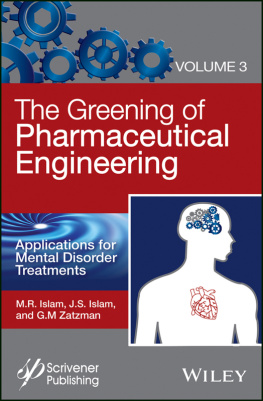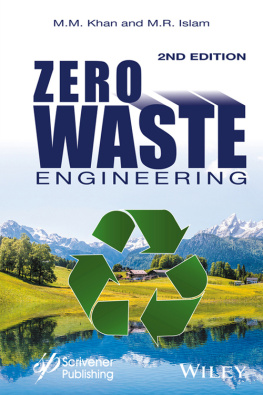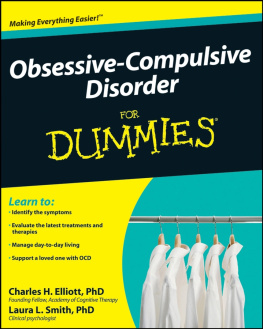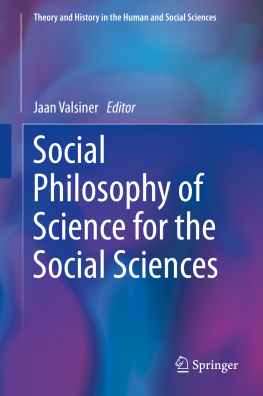Islam Jaan S. - The Greening of Pharmaceutical Engineering, Applications for Mental Disorder Treatments
Here you can read online Islam Jaan S. - The Greening of Pharmaceutical Engineering, Applications for Mental Disorder Treatments full text of the book (entire story) in english for free. Download pdf and epub, get meaning, cover and reviews about this ebook. year: 2017, genre: Romance novel. Description of the work, (preface) as well as reviews are available. Best literature library LitArk.com created for fans of good reading and offers a wide selection of genres:
Romance novel
Science fiction
Adventure
Detective
Science
History
Home and family
Prose
Art
Politics
Computer
Non-fiction
Religion
Business
Children
Humor
Choose a favorite category and find really read worthwhile books. Enjoy immersion in the world of imagination, feel the emotions of the characters or learn something new for yourself, make an fascinating discovery.
- Book:The Greening of Pharmaceutical Engineering, Applications for Mental Disorder Treatments
- Author:
- Genre:
- Year:2017
- Rating:5 / 5
- Favourites:Add to favourites
- Your mark:
- 100
- 1
- 2
- 3
- 4
- 5
The Greening of Pharmaceutical Engineering, Applications for Mental Disorder Treatments: summary, description and annotation
We offer to read an annotation, description, summary or preface (depends on what the author of the book "The Greening of Pharmaceutical Engineering, Applications for Mental Disorder Treatments" wrote himself). If you haven't found the necessary information about the book — write in the comments, we will try to find it.
Islam Jaan S.: author's other books
Who wrote The Greening of Pharmaceutical Engineering, Applications for Mental Disorder Treatments? Find out the surname, the name of the author of the book and a list of all author's works by series.
The Greening of Pharmaceutical Engineering, Applications for Mental Disorder Treatments — read online for free the complete book (whole text) full work
Below is the text of the book, divided by pages. System saving the place of the last page read, allows you to conveniently read the book "The Greening of Pharmaceutical Engineering, Applications for Mental Disorder Treatments" online for free, without having to search again every time where you left off. Put a bookmark, and you can go to the page where you finished reading at any time.
Font size:
Interval:
Bookmark:

- Chapter 1
- Chapter 2
- Chapter 3
- Chapter 4
- Chapter 5
- Chapter 6
- Chapter 8
- Appendix A
- Appendix C
- Chapter 1
- Chapter 2
- Chapter 3
- Chapter 4
- Chapter 5
- Chapter 6
- Chapter 7
- Chapter 8
- Chapter 9
- Appendix A
- Appendix C
Scrivener Publishing
100 Cummings Center, Suite 541J
Beverly, MA 01915-6106
Publishers at Scrivener
Martin Scrivener ()
Phillip Carmical ()
Volume 3
M. R. Islam
Emertec Research and Development and Dalhousie University, Halifax, Nova Scotia, Canada
Jaan S. Islam
Dalhousie University, Halifax, Nova Scotia, Canada
G.M. Zatzman
Emertec Research and Development, Halifax, Nova Scotia, Canada

This edition first published 2017 by John Wiley & Sons, Inc., 111 River Street, Hoboken, NJ 07030, USA and Scrivener Publishing LLC, 100 Cummings Center, Suite 541J, Beverly, MA 01915, USA 2017 Scrivener Publishing LLC
For more information about Scrivener publications please visit www.scrivenerpublishing.com.
All rights reserved. No part of this publication may be reproduced, stored in a retrieval system, or transmitted, in any form or by any means, electronic, mechanical, photocopying, recording, or otherwise, except as permitted by law. Advice on how to obtain permission to reuse material from this title is available at http://www.wiley.com/go/permissions.
Wiley Global Headquarters
111 River Street, Hoboken, NJ 07030, USA
For details of our global editorial offices, customer services, and more information about Wiley products visit us at www.wiley.com.
Limit of Liability/Disclaimer of Warranty
While the publisher and authors have used their best efforts in preparing this work, they make no representations or warranties with respect to the accuracy or completeness of the contents of this work and specifically disclaim all warranties, including without limitation any implied warranties of merchantability or fitness for a particular purpose. No warranty may be created or extended by sales representatives, written sales materials, or promotional statements for this work. The fact that an organization, website, or product is referred to in this work as a citation and/or potential source of further information does not mean that the publisher and authors endorse the information or services the organization, website, or product may provide or recommendations it may make. This work is sold with the understanding that the publisher is not engaged in rendering professional services. The advice and strategies contained herein may not be suitable for your situation. You should consult with a specialist where appropriate. Neither the publisher nor authors shall be liable for any loss of profit or any other commercial damages, including but not limited to special, incidental, consequential, or other damages. Further, readers should be aware that websites listed in this work may have changed or disappeared between when this work was written and when it is read.
Library of Congress Cataloging-in-Publication Data
ISBN 978-1-119-18376-1
Recent political events in the United States have brought the healthcare debate back to the forefront of public discourse. While debate rages about universal payer or whether healthcare is a right or a privilege, etc., the wheel is not being reinvented. President Richard Nixon signed into law the Health Maintenance Organization Act of 1973. This law decriminalized extracting private profit out of the healthcare system. Prior to this, medical insurance agencies, hospitals, clinics and even doctors, could not function as for-profit business entities.
Meanwhile: how a real healthcare system should look is established in this book series on The Greening of Pharmaceutical Engineering. Such a system would include the following:
- science of medicine must be broken down to create science of health;
- care should be brought back to healthcare;
- there must be recognition that care-giving takes place continuously within a family, then community, then the region;
- profiteering should be banned and profiting from peoples misery should be treated as treasonous.
The fact that such ideals seem not to be present in the minds of those waging this struggles leading edge (e.g. radical liberals or extremist libertarians) suggests there is still no clear path forward. Until we can create a real paradigm shift, society will remain stuck choosing the lesser of two evils.
This volume gets to the root of the problem by another path. It unfurls an option radically divergent from both the left and the right, in which people would no longer be reduced to choosing between the equally toxic options of chemicals for everything and westernized version of yoga that purports to free ones mind of any thought. This book makes a case in favor of a truly sustainable approach. It calls out the current fashion of new science that has been giving us the culture of antidepressants, a culture that leads to suicide
Earlier in volumes 1 and 2, we established how New Science (the post-Newtonian obsession with short-term and tangibles) has disconnected humanity from conscience. It has done so by asserting a fake Creator that it calls Nature. This nature turns out to be the Money god, enslaving its adherents in a remodeled new trinity of financial establishment, media establishment, and the political establishment. Under this arrangement, the scientists once again form the most faithful priesthood, all too happy to propagandize the scheme of the Money god. As discussed earlier, this latest new science recycles Santa Claus and tooth fairy falsehoods to promote the sophistry of big bang, evolution (as opposed to natural selection), Newtons laws (which remain true independently of the passage of time), quantum theory (with its utterly fantastic cat courtesy of Prof. Schrodinger) and founded upon ever more illogical versions of original sin, the Trinity, and the flat earth idea.
This book reconnects humanity with conscience and brings back the original scientific definition of grounding in order to regain mental health. By doing so, this book rescues people from the bombarding of alternate fact, fake news, and new-science sophistry.
This volume documents the most significant firsts of the modern era, identifying whatever is truly unique about humanity. This is analyzed from both tangible and intangible perspectives. This unique feature has eluded scientists, theologians alike for at least a millennium.
This volume begins with the purpose of human life. Then it discusses the way to ground psychologically and to seek a lifestyle that assures maximum success. How curious that we had to discuss this very notion at the dawn of the new millennium whereas there are hundreds of thousands of books, all focusing on 1001 ways to be successful before even considering the true purpose of life, let alone the impetus of a successful life.
In this book, a refreshingly new approach is systematically introduced and embraced. It considers a pre-puberty child as a model for human beings. It uses this model to define good behavior. This child development model is not like the lone researcher la Piaget or the product of the environment model of Vygotsky or even the system model of Bronfenbrenner. None of these childhood models is free from dogmatic premises that recapitulate different versions of the original sin narration. The childhood model that was used in this book is the one that has a different starting point for defining humanity, acceptable behavior, accountability, and psychological grounding. The book lists 100 godly qualities and shows each such quality has to be optimized in a lifestyle that will minimize mental and emotional maladies. This volume discusses ADHD and autism as part of natural qualities of children. Such a narration can help illuminate why conventional special educational curriculum and therapies have failed beyond giving some short-term antidotes. Natural traits for each child are presented and ways to capitalize on these natural traits in order to prepare children for their maturing into responsible adulthood as well as for remedying adults childhood trauma or pre-disposed psychological conditions.
Next pageFont size:
Interval:
Bookmark:
Similar books «The Greening of Pharmaceutical Engineering, Applications for Mental Disorder Treatments»
Look at similar books to The Greening of Pharmaceutical Engineering, Applications for Mental Disorder Treatments. We have selected literature similar in name and meaning in the hope of providing readers with more options to find new, interesting, not yet read works.
Discussion, reviews of the book The Greening of Pharmaceutical Engineering, Applications for Mental Disorder Treatments and just readers' own opinions. Leave your comments, write what you think about the work, its meaning or the main characters. Specify what exactly you liked and what you didn't like, and why you think so.









